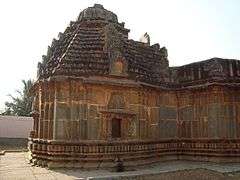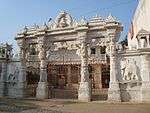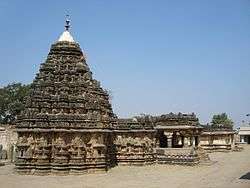Lakshmeshwara
| Lakshmeshwara ಲಕ್ಷ್ಮೇಶ್ವರ | |
|---|---|
|
Someshwara temple complex at Lakshmeshwara | |
 Lakshmeshwara  Lakshmeshwara Location in Karnataka, India | |
| Coordinates: 15°08′N 75°28′E / 15.13°N 75.47°ECoordinates: 15°08′N 75°28′E / 15.13°N 75.47°E | |
| Country |
|
| State |
|
| District | Gadag |
| Taluk | Shirahatti |
| Lok Sabha Constituency | Haveri |
| Elevation | 634 m (2,080 ft) |
| Population (2001) | |
| • Total | 33,411 |
| Languages | |
| • Official | Kannada |
| Time zone | IST (UTC+5:30) |
| PIN | 582 116 |
| ISO 3166 code | IN-KA |
| Vehicle registration | KA 26 |
Lakshmeshwara (Kannada: ಲಕ್ಷ್ಮೇಶ್ವರ ) is a town in Shirahatti taluk, Gadag district, in the Indian state of Karnataka. It is about 50 km from Gadag and 55 km from Hubli.[1] Lakshmeshwara is an agricultural trading town.
There are many important temples in this historic town, including the Shiva temple, the "Someshwara Temple". There are two ancient Jain temples (Sannabasadi and Shankabasadi) in the town, as well as a notable Jamma Masjid. Lakshmeshwara is also home for many smaller shrines, a dargah, the Kodiyellamma temple, the Mukha Basavanna shrine, and a gigantic idol of Suryanarayana.
Lakmeshwar is 55 km from Hubli and 50 km from Gadag. There are direct trains from Bangalore to Lakmeshwar.
Geography
Lakshmeshwar is at 15°08′N 75°28′E / 15.13°N 75.47°E.[2] It has an average elevation of 634 metres (2080 feet).
Demographics
As of 2001 India census,[3] Lakshmeshwar had a population of 33,411. Males constitute 51% of the population and females 49%. Lakshmeshwar has an average literacy rate of 62%, higher than the national average of 59.5%: male literacy is 70%, and female literacy is 53%. In Lakshmeshwar, 13% of the population is under 6 years of age.
History
Lakshmeshwara is famous for prolific culture and literature. It is a place with rich heritage in Karnataka hence it is called as Tirulugannada Nadu. Many kings have patronised the place.
Lakshmeshwar or ancient Huligere or Puligere[4] was the capital of Puligere-300.[5] Puligere means pond of tigers. There are theories of the origin of the name Lakshmeshwara: from King Lakshmanarasa who was ruling Puligere or from the temple called Lakshmi-Lingana gudi, which means the temple of Lakshmi.
Other names include Purigere, Porigere, Purikanagar and Pulikanagar.
Adikavi Pampa wrote his famous poetry in Lakshmeshwara.
Many Jain saints and writers have flourished here.[5] They include Devachakra Bhattaraka, Shankanacharya, Hemadevacharya, Padmasena, Tribhuvana Chandra Padmita and Rama Dvacharya.
Someshwara temple complex
The most important monument at Lakshemshwar is the Someshwara temple complex (11th century).[6] The temple complex with three main entrances is surrounded by high walls look like a fort. It is a splendid specimen of Chalukya architecture.
In middle of the temple complex, there is a Someshwara temple, surrounded by many small temples mainly dedicated to Shiva, along the compound wall, built with granite, some halls in the complex meant for resting devotees.
Someshwara temple
Someshwara temple with the traditional structures of a temple includes a garbha griha, an ardha mantapa or halfway hall, a navaranga and a mukha mantapa or entrance porch.
The Nandi and Shiva Parvati idols in the temple are exquisitely sculpted. These idols are referred to as Saurashtra Someshwara, as these idols were brought by a Shiva devotee from Saurashtra and installed at Lakshmeshwara.
Open well
Inside the Someshwara temple complex, behind the temple, there is an open step-well. This step-well, being richly carved and ornamented, is of architectural and artistic significance.
Kannada inscriptions
At the Someshwara temple complex, there are many Kannada inscription.[7] Over 50 stone inscriptions (records) show the cultural importance.
- The Kannada (Kannadiga) poet Kayasena of Mulgund, who wrote in the Bharmamrita, was a disciple of Narendrasena II of the Lakshmeshwar inscription of 1081.
- Lakshmeshwar inscription of the reign of Jagadekamella II.
- Two Jain Inscription of Mulgund and Lakshmeshwar
- The Lakshmeshwar inscriptions (in Kannada dated January 13, 735), during 733–744 CE Vikramaditya II was the son of King Vijayaditya who ascended the Badami Chalukyas throne following the death of his father.
 Mantapa (hall) with lathe turned pillars at Someshwara temple
Mantapa (hall) with lathe turned pillars at Someshwara temple Shikhara over the sanctum of Someshwara temple
Shikhara over the sanctum of Someshwara temple Step-well at Someshwara temple complex
Step-well at Someshwara temple complex Open well at Someshwara temple complex
Open well at Someshwara temple complex Someshwara temple
Someshwara temple Kannada inscriptions at Someshwara temple complex
Kannada inscriptions at Someshwara temple complex
Jain Basadis
Jainism related to Lakshmeshwara has long history.[8]
- At Lakshmeshwara, during the period of Kirtivarma II, the Jinalaya built by Kumkuma Mahadevi.
- Kalyani Chalukyas most important Jinalayas Brahma Jinalaya at Lakkundi, Charantimatha at Aihole and Sankha Jinalya at Lakshmeswar. The Sankha Jinalaya at Lakshmeshwara is dedicated to Neminatha (as per many inscriptions this was an important Jinalaya). Sendraka Durgashakti, a feudatory of Pulakeshin II is said to have given gifts to this temple. An inscription of Vinayaditya (dated 686 A.D.) refers to a grant to Jain acharya of Devagana and mulasangha.
- Epigraph dated 729 A. D. of Vijayaditya mentions a grant to Niravadya Pandita who was to house pupil of Sri Pujyapada. Another inscription of Vikramaditya II (dated 734 A. D.) mentions gifts to Sweta Jinalaya.
- The Jaina monument of the Rashtrakuta period found Lakshmeshwar.
Lakshmeshwara is one of the ancient Jain centres. Many Jain temples are mentioned in the inscriptions.[5]
Shanka Basadi


Of the two historical Jinalayaa at Lakshmeswar, the more famous is Sankha Jinalaya, also called Sahasrakuta Jinalaya,[5] in the BastiBana area. This takes back the history of Lakeshmeshwara to the 8th century; though the temple is in Chalukya style it has undergone many modifications and renovations.
Neminath (Shankha is the symbol of Neminath), the 22nd Jain thirthankara, is the presiding deity of this Jain Basadi.
Basadi, which consists of a Garbhagriha, a large Ardhamandapa, larger Mahamandapa and a Rangamandapa.
- The rangamandapa has three entrances (south, north and west). It has a chaturmukha structure in diminutive model, each of which carries three figures. it has a rekhanagara shikhara. The unique feature of this temple is the Sahasrakuta Jinabimba in minute form.
- There is a Manasthamba erected in front of the temple.
- There are ventilated walls in front of the temple, whereas yakshas and yakshis can be found in the other walls. There are many splendid carvings of dancers and musicians.
- Inside the temple one can find the rare monolithic piece of Sahasra Jinabimbas (SahastraKut Jinalay) and the idols of Dharnendra and Padmavathi.
- Many mutilated Jain idols can be found on the wall of a well nearby.
- Adikavi Pampa wrote Adi Purana, seated in this Basadi.
- Basadi is in ruins and renovated; it presents the interest of the Kalyani Chalukyas in Jain architecture.
The other Jinalaya there is a Trikuta dedicated to 'Anantanatha.
Ananthanatha basadi
Another Jain temple at Lakshmeshwara is the Ananthanatha Basadi, built in AD 1250, which is in the middle of the town. This Basadi is an example of the Chalukya style of architecture. The idol of Ananthanatha, one of the 24 Thirthankars, is installed in the sanctum sanctorum of the shrine.
Islamic monuments
The Dargah (mausoleum) of Hazrat Sulaiman Badshah Qadri, also known as the "Doodh Nana Valli" is located in the town. The dargah is known as "Doodh Nana" because it is customary for people to bring milk ("doodh") to perform fateha at this mausoleum. The holy man buried here is Hazrat Sulaiman Badshah Qadri Baba, a descendant of Hazrat Peeran-e-Peer Hazrat Ghouse-e-Azam Dastageer Hazrat Shaik Abdul Qader Gillani Rizwan Allahi Thaalah Alaihi Ajmaeen. This Sufi saint is very famous and even his painting photos are sold in different dargahs all over south India.
Bade Nana Dargah
During Adilshahi rule (Bijapur Sultanate), they built monuments like Masjid, Dargah. They adapted the Indo-Saracenic architectural style.
Hazarath syed Ankushkhan wali(reh) Dargah named after Ankuskhan of Bijapur. The Dargha is about one km from the KSRTC bus stand Lakshmeshwar at manjalapur. (he was nobel saint of aadil shahi period & descendant of gujrati sayed's his dargah also known as syed laal shabaaz bukhari rehmatullah alai),bade nana. It is as old as Jumma Masjid, which is constructed in Indo-Saracenic architecture style. This daragah is managed by direct lenial descendants sayed shah soofisab Al bukhari Al hussaini urf Dr dada pacha baba saheb peerzade and family.
Jumma Masjid
At Lakshmeshwar there is an artistically raised mosque (masjid)[9] of Adilshahi times.
The Jumma Masjid at Lakshmeshwara which dates back to the time of the Adilshahi rule. The mosque was built in 1617 by Ankush Khan. Juma Masjid In the same Street of Dargah Shareef you will find the Juma Masjid, a stone mosque constructed by Syed Ankush Khan in 1617 AD. Even the chains are made of stones. The masjid attracts a large number of tourists and it comes under Archeological Survey of India.
Jumma Masjid is constructed in Indo-Saracenic style. The massive doors of the mosque are like a fort entrance. The mosque has two tall minars and a large semicircular dome. There are Dravidian style chains hanging across the ceiling of the mosque.
Karewadimatha
It is one of the oldest Veerashaiva matha in laxmeshwara.
See also
- Shigli
- Western Chalukya
- Western Chalukya architecture
- Lakkundi
- Dambal
- Kundgol
- Annigeri
- Magadi Bird Sanctuary
- Sudi
- Gadag
- Mahadeva Temple (Itagi)
- Haveri
- North Karnataka
- Tourism in North Karnataka
Further reading
- SAMAVASARAN (Research Articles-2015) by Dr. Appanna N. Hanje, Vidyashree Prakashan, Alagawadi. Cell-9886592927
- LAKKUNDIY BASADIGALU (2015) by Dr. Appanna N. Hanje, Vidyashree Prakashan, Alagawadi. Cell-9886592927
References
- ↑ "Lakshmeshwar". Retrieved 2009-02-10.
- ↑ Falling Rain Genomics, Inc - Lakshmeshwar
- ↑ "Census of India 2001: Data from the 2001 Census, including cities, villages and towns (Provisional)". Census Commission of India. Archived from the original on 2004-06-16. Retrieved 2008-11-01.
- ↑ "Karnataka, The Tourist Paradise". Retrieved 2009-02-25.
- 1 2 3 4 "LAKSHMESHWARA". Retrieved 2009-02-10.
- ↑ "Attention please!, Deccan herald". Deccan herald. Archived from the original on April 6, 2012. Retrieved 2009-02-10.
- ↑ "Full text of "EPIGRAHIA INDICA VOL 16" , LAKSHMESHWAR". Retrieved 2009-03-17.
- ↑ "Jaina Monuments in North Karnataka". by Dr. A. V. Narasimha Murthy. Archived from the original on August 23, 2009. Retrieved 2009-03-17.
- ↑ "Karnataka, The Tourist Paradise". Retrieved 2009-02-10.
